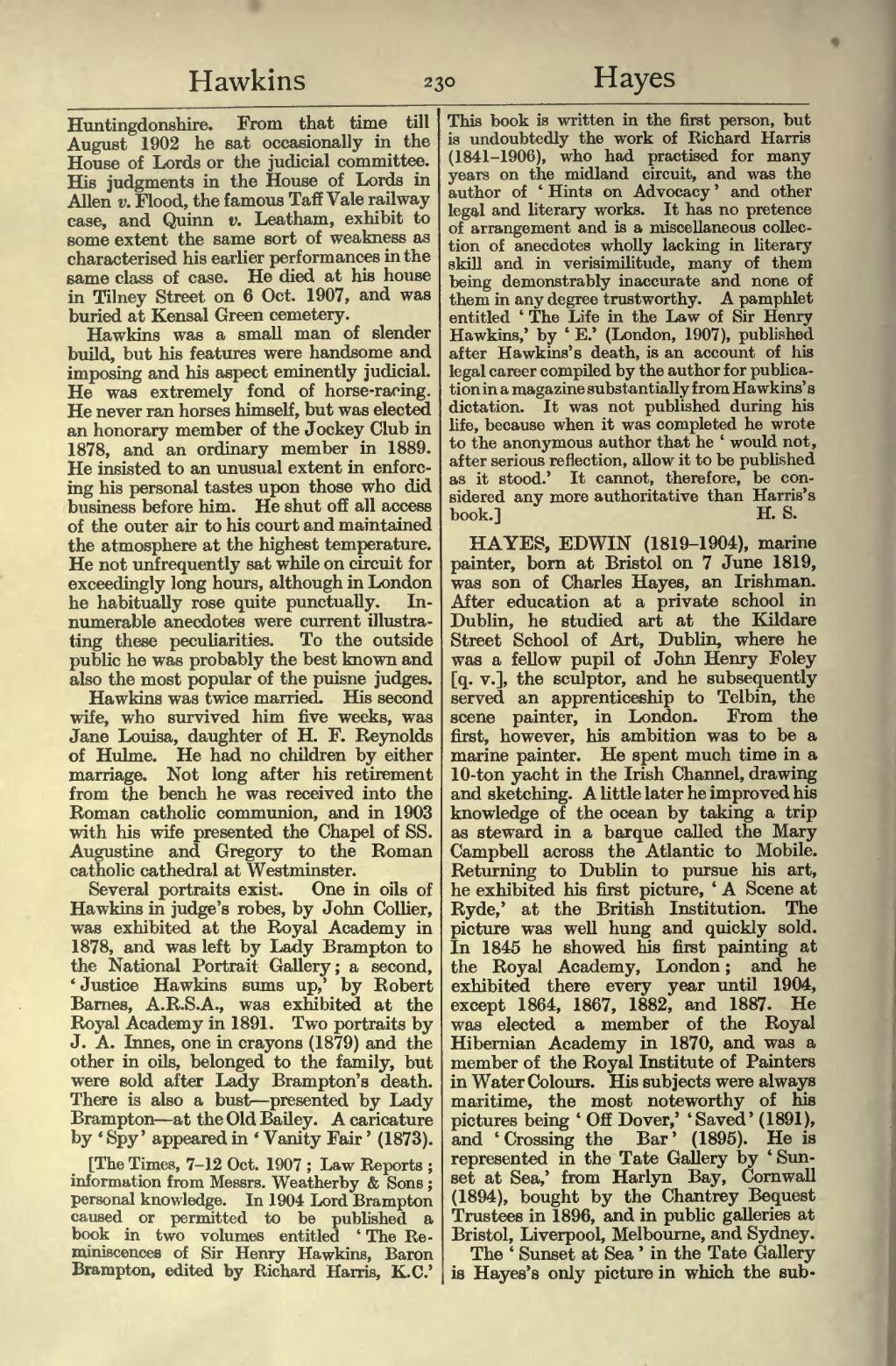Huntingdonshire. From that time till August 1902 he sat occasionally in the House of Lords or the judicial committee. His judgments in the House of Lords in Allen v. Flood, the famous Taff Vale railway case, and Quinn v. Leatham, exhibit to some extent the same sort of weakness as characterised his earlier performances in the same class of case. He died at his house in Tilney Street on 6 Oct. 1907, and was buried at Kensal Green cemetery.
Hawkins was a small man of slender build, but his features were handsome and imposing and his aspect eminently judicial. He was extremely fond of horse-racing. He never ran horses himself, but was elected an honorary member of the Jockey Club in 1878, and an ordinary member in 1889. He insisted to an unusual extent in enforcing his personal tastes upon those who did business before him. He shut off all access of the outer air to his court and maintained the atmosphere at the highest temperature. He not unfrequently sat while on circuit for exceedingly long hours, although in London he habitually rose quite punctually. Innumerable anecdotes were current illustrating these peculiarities. To the outside public he was probably the best known and also the most popular of the puisne judges.
Hawkins was twice married. His second wife, who survived him five weeks, was Jane Louisa, daughter of H. F. Reynolds of Hulme. He had no children by either marriage. Not long after his retirement from the bench he was received into the Roman catholic communion, and in 1903 with his wife presented the Chapel of SS. Augustine and Gregory to the Roman catholic cathedral at Westminster.
Several portraits exist. One in oils of Hawkins in judge's robes, by John Collier, was exhibited at the Royal Academy in 1878, and was left by Lady Brampton to the National Portrait Gallery; a second, 'Justice Hawkins sums up,' by Robert Barnes, A.R.S.A., was exhibited at the Royal Academy in 1891. Two portraits by J. A. Innes, one in crayons (1879) and the other in oils, belonged to the family, but were sold after Lady Brampton's death. There is also a bust — presented by Lady Brampton — at the Old Bailey. A caricature by 'Spy' appeared in 'Vanity Fair' (1873).
[The Times, 7-12 Oct. 1907 ; Law Reports ; information from Messrs. Weatherby & Sons ; personal knowledge. In 1904 Lord Brampton caused or permitted to be published a book in two volumes entitled 'The Reminiscences of Sir Henry Hawkins, Baron Brampton, edited by Richard Harris, K.C This book is written in the first person, but is undoubtedly the work of Richard Harris (1841-1906), who had practised for many years on the midland circuit, and was the author of 'Hints on Advocacy' and other legal and literary works. It has no pretence of arrangement and is a miscellaneous collection of anecdotes wholly lacking in literary skill and in verisimilitude, many of them being demonstrably inaccurate and none of them in any degree trustworthy. A pamphlet entitled 'The Life in the Law of Sir Henry Hawkins,' by 'E.' (London, 1907), published after Hawkins's death, is an account of his legal career compiled by the author for publication in a magazine substantially from Hawkins's dictation. It was not published during his life, because when it was completed he wrote to the anonymous author that he 'would not, after serious reflection, allow it to be published as it stood.' It cannot, therefore, be considered any more authoritative than Harris's book.]
HAYES, EDWIN (1819–1904), marine painter, born at Bristol on 7 June 1819, was son of Charles Hayes, an Irishman. After education at a private school in Dublin, he studied art at the Kildare Street School of Art, Dublin, where he was a fellow pupil of John Henry Foley [q. v.], the sculptor, and he subsequently served an apprenticeship to Telbin, the scene painter, in London. From the first, however, his ambition was to be a marine painter. He spent much time in a 10-ton yacht in the Irish Channel, drawing and sketching. A little later he improved his knowledge of the ocean by taking a trip as steward in a barque called the Mary Campbell across the Atlantic to Mobile. Returning to Dublin to pursue his art, he exhibited his first picture, 'A Scene at Ryde,' at the British Institution. The picture was well hung and quickly sold. In 1845 he showed his first painting at the Royal Academy, London ; and he exhibited there every year until 1904, except 1864, 1867, 1882, and 1887. He was elected a member of the Royal Hibernian Academy in 1870, and was a member of the Royal Institute of Painters in Water Colours. His subjects were always maritime, the most noteworthy of his pictures being 'Off Dover,' 'Saved' (1891), and 'Crossing the Bar' (1895). He is represented in the Tate Gallery by 'Sunset at Sea,' from Harlyn Bay, Cornwall (1894), bought by the Chantrey Bequest Trustees in 1896, and in public galleries at Bristol, Liverpool, Melbourne, and Sydney.
The 'Sunset at Sea' in the Tate Gallery is Hayes's only picture in which the sub-
